This is a list of artificial intelligence (AI) design tools, statistics and trends of their usage, current standing and growth updated through 2023.
In the rapidly evolving world of design, artificial intelligence is making a profound impact.
From Midjourney to Mar, AI design tools are empowering creative professionals to streamline workflows, boost productivity, and create cutting-edge designs with unprecedented ease.
We’ll explore these data-driven insights and how these tools are revolutionizing the way we conceptualize, iterate, and execute design projects. While this list is by no means exhaustive, it is rather comprehensive to give you a good idea of some leading Design tools that are utilizing AI to their advantage and the advantage of their users.
Contents
The Rising Demand for AI Design Tools
Interest in AI design by State in the United States
The Impact on Design Efficiency
Enhanced Personalization and User Experience
The Power of AI in Creativity
AI Design Companies, Trends, and Statistics
- Figma
- Adobe Firefly, XD & Illustrator
- Sketch
- Axure RP
- Marq
- Framer
- InVision
- Proto.io
- Midjourney
- Canva
- Dream Studio
- CorelDRAW
- TopazLabs
- Uizard
- Autodraw
Growth in AI-Integrated Design Platforms
Data Security and Privacy Concerns
Bridging the Gap Between Designers and Developers
Conclusion
The image below comes from explodingtopics.com showcasing some of the high level statistics of the AI industry as a whole including all types of generative AI including but not limited to design.
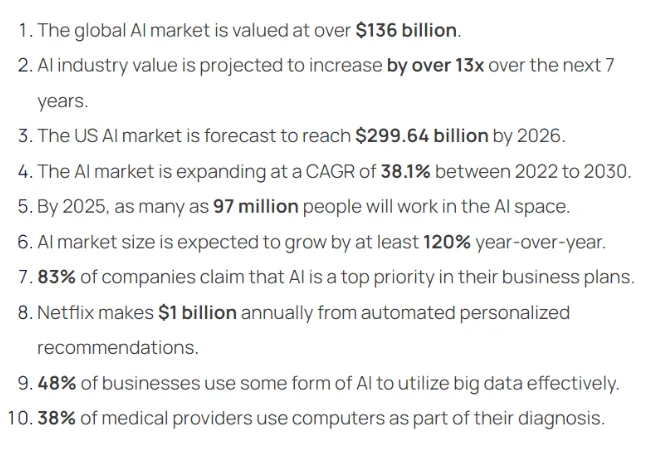
The Rising Demand for AI Design Tools
The demand for AI design tools has witnessed an unprecedented surge in 2023. According to Google trends, the search volume for AI design related tools and software has increased 1700% from 2022 to 2023 alone.

Interest in AI design by State in the United States
The interest in AI design when broken down into sub topics and related queries spans from ai image generation to Ai design tools that allow teams to take components of AI and marry them to their own brand and designs speeding up and making more efficient their own design teams and processes.
The interest in AI design across the United States is ubiquitous. The regions/states in the top 5 positions of high interest are; 1. District of Columbia 2. California 3. Washington 4. Hawaii and 5. Utah

The Impact on Design Efficiency
AI design tools have proven instrumental in streamlining design workflows. By automating repetitive tasks and offering real-time suggestions, these tools save designers valuable time and effort. Surveys indicate that a significant percentage of design professionals believe that AI has significantly improved their design efficiency, allowing them to focus on more creative and strategic aspects of their work.
IDC suggests that generative design, even more broadly generative AI, finds value in creating something for humans to react to. With AI’s initial start and its recommendations overseen by humans creates increased velocity and efficiency in creating on-brand design.
Enhanced Personalization and User Experience
In the age of personalized experiences, AI design tools are helping designers cater to individual user preferences more effectively. By analyzing user data and behavioral patterns, AI-powered tools provide valuable insights into user preferences and expectations. This data-driven approach enables designers to craft highly tailored and user-centric designs, resulting in enhanced user experiences.
Per Gartner, “A good experience designer brings user insights from research as well as knowledge of human psychology – and blends them with the organization’s product vision”. They continue, “Advances in AI will mean that designers spend less time building . . and more time focusing on solving real problems for users”.
The Power of AI in Creativity
Contrary to the misconception that AI stifles creativity, statistics reveal that AI design tools foster innovation and creativity. With AI-generated design suggestions and intelligent pattern recognition, designers are inspired to explore novel ideas and experiment with new concepts that they may not have considered otherwise. This synthesis of human creativity and AI assistance leads to groundbreaking and aesthetically captivating designs.
AI Design Companies, Trends, and Statistics
As mentioned above, the interest in AI design is wide because the use case of artificial intelligence in design is also quite wide. While AI image generation alone has made massive strides in 2023, for many companies looking to streamline their own design teams and processes, the AI images alone don’t fit the bill. Which is why there are design tools now that offer AI as a part of the complete design tool. *Data provided by Crunchbase, SEMrush, and Google Trends.
1. Figma:
Figma is a collaborative design tool that allows teams to work together on UI/UX design, prototyping, and user testing. It has plugins and integrations that support AI design-related functionalities.
Figma has witnessed a significant rise in popularity among designers, with over 4 million users as of September 2021. Its collaborative features and cloud-based nature have contributed to its widespread adoption.
See Figma’s cumulative fundraising over time and note the 150% increase year over year Q2 of 2020 to Q2 of 2021.
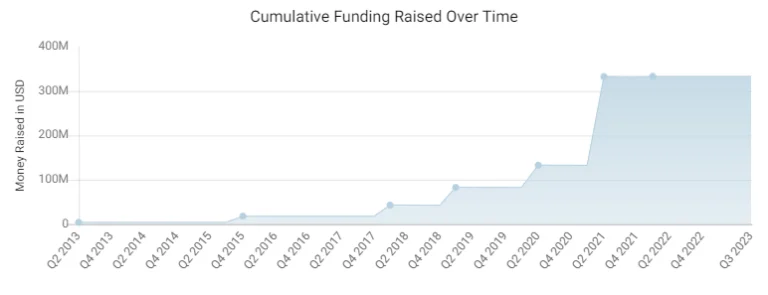
Also note the considerable increase in organic presence up 115% year over year (June 2022 to June 2023, website traffic coming from organic search results in search engines due to content and features put out meeting their audience needs.

Below you can see the increase in brand awareness by the search volume trend in Google for the keyword “Figma”. While relative to its own position, from June 2021 to June of 2023, Figma has seen a 355% increase in awareness and demand.

2. Adobe Firefly, XD & Illustrator:
We would be remiss to not include the vast world of adobe when talking about design tools. And Adobe has certainly not missed the AI train. With several products fulfilling different needs and niches, Adobe has cast a wide net helping many different audiences. The catch, you’ll pay quite the penny to get all the features from all the products. Adobe Firefly is an AI design tool that can generate images from text. It is still in beta, which means you may have to get on a wait list and be a subscriber to other Adobe tools to get a chance to test it out.
Adobe XD is a vector-based design tool that supports designing and prototyping experiences for websites, mobile apps, and more. It integrates with Adobe’s Sensei AI technology to assist designers with content-aware layout suggestions and other AI-powered features.
Adobe XD has gained prominence as part of the Adobe Creative Cloud suite, and by September 2021, it had over 3 million users. Adobe’s reputation and continuous updates have attracted designers to use XD as their go-to design and prototyping tool.
Adobe Illustrator is a vector graphics editor that is widely used in various design fields. Although it’s not an AI-specific tool, Adobe has been incorporating AI features into its Creative Cloud suite, which includes Illustrator.
Check out the increased organic performance for Adobe over the last 7 years with the amount of organic search keywords they’ve captured. They’ve seen a 32% YoY increase with an 80% increase in 2 years and a whopping 886% increase 7 years.

Interestingly enough, despite the increased performance with their site, the volume of people searching adobe in general has tapered in recent years as seen by the trendline below representing users searching for “adobe” in Google. This could be due to the generic parent brand vs each individual product that they offer which was not taken into consideration.

3. Sketch:
Sketch is a macOS-based design tool popular among UI/UX designers. While it doesn’t have native AI capabilities, it can be enhanced with various plugins that incorporate AI functionalities.
As of September 2021, Sketch had a strong presence in the macOS-based design tool market, with over 1.5 million active users. It remains one of the top choices for UI/UX designers who value its performance and ease of use.
See the organic performance trend of the last 5 years below. Sketch has seen a 7% growth in organic presence year over year and a 49% increase in 2 years.

Despite its popularity, Sketch has seen a rather consistent decline in trend for overall volume of searches for its primary branded keyword “sketch” (segmented by the company name vs the word itself).

4. Axure RP
Axure RP is a prototyping and wireframing tool that allows designers to create interactive prototypes for websites and applications. It may not have native AI features, but it can be integrated with external AI tools.
Below you can see Axure RP has seen some volatility over the last 5 years performing quite a bit lower in the organic search results of Google than it has. While it is currently trending positively, it has some ground to make up for. Axure saw a 3% drop year over year and a 29% drop from 2 years prior.

The trend of search volume tells a similar story with the primary branded keyword “axure rp” seeing a negative trend through the last couple years.

5. Marq:
Marq is an innovative design tool that has been gaining significant traction in the design industry. Leveraging cutting-edge artificial intelligence capabilities, Marq aims to revolutionize the way designers conceptualize, create, and iterate on their projects. In this section, we explore some key statistics and emerging trends that highlight the impact of Marq in the design landscape.
Marq has seen a remarkable surge in user adoption. Within just six months, Marq’s user base has grown to over one million active users, making it one of the fastest-growing AI design tools on the market. Designers from diverse backgrounds, including UI/UX designers, graphic artists, and marketers, have embraced Marq for its intuitive AI-driven features.
While Marq has undergone a relatively recent rebrand to an entirely new domain, they’ve retained much of their previous organic performance, and have since increased their brand presence in the market as seen by the short period of time available in the trendline below.
While it’s not an apples to apples comparison as there’s a bit of a ramp up period to anticipate with a new brand going live, Marq boasts a 6062% increase YoY. Let’s factor in the ramp up taking a full month’s worth of data and comparing it to the next closest month this year, Marq still shows a 73% increase year over year.

It’s clear from the volume of their branded keyword “marq” in Google trends, that Marq still has opportunity to grow, but is certainly trending positively in the last several years despite the rapidly changing industry, AI, and the market pitfalls with the worldwide pandemic and other recent anomalies.
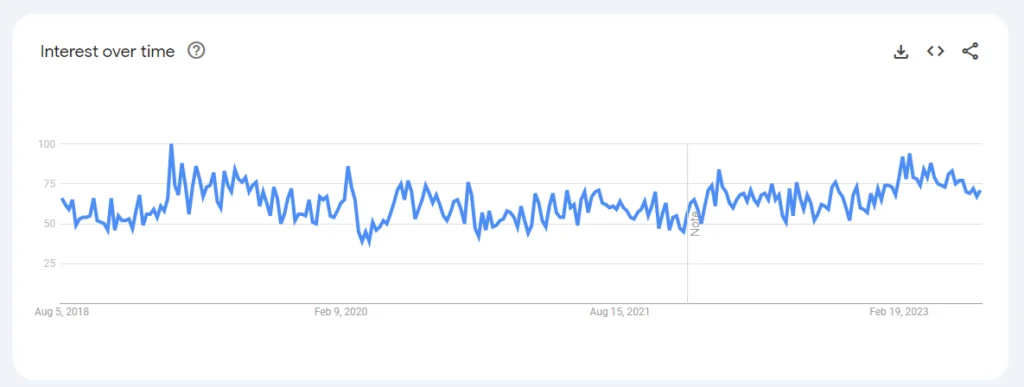
6. Framer:
Framer is a design tool that enables designers to create interactive and animated prototypes. It also offers integrations with AI-powered tools to enhance the design process.
Framer, known for its powerful prototyping capabilities, had gained traction among designers and had over a million users by September 2021.
Note the cumulative funding raised over the last 5 years, with 267% increase from 2017 to 2018 and an additional growth of 81% from Q1 to Q3 of 2023.
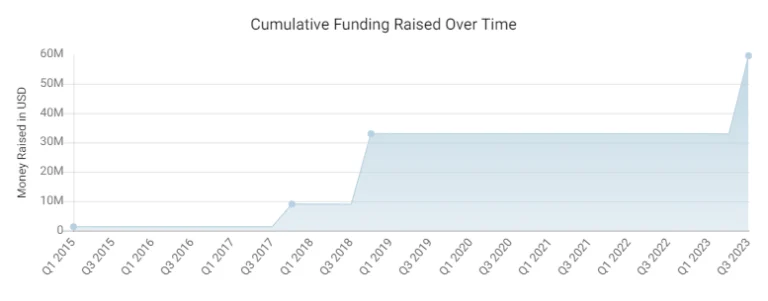
Below you can see that despite a considerable setback of website performance, Framer has regained and continues to thrive in the acquisition of new awareness through the keywords obtained for organic search. From their low point to their current high (1 year of time) they’re up 621%. Looking at the year prior before the set back, Framer is seeing a 98% increase from 2 years ago.

7. InVision:
InVision is a digital product design platform that allows teams to collaborate on design, prototyping, and user testing. It integrates with various AI plugins and external AI tools to facilitate the design process.
InVision has been a dominant player in the digital product design platform market, boasting over 7 million users as of September 2021. See the growth and anticipated growth manifest in the cumulative funding that they’ve raised over the last 10 years. Certainly a consistently healthy and robust measured effort trending positively. According to crunchbase their fundraising was up 48% year over year from 2017 to 2018 and has sustained through the years.
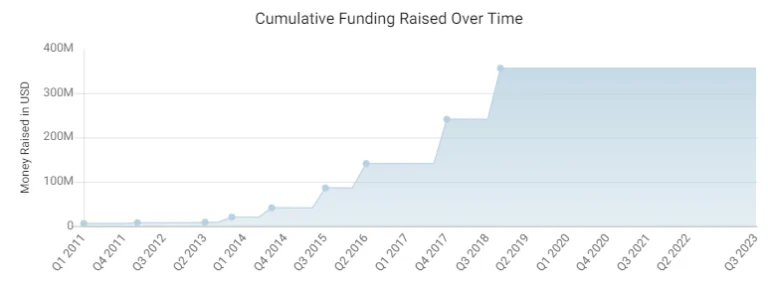
InVision’s website, however, can’t say the same. While organic presence in Google is not a primary indication of a business’ health, it can be an indicator of spending money in the right place, being aware of important aspects like digital presence, and potentially other factors like overall industry interest. Year over year, InVision has seen a 26% drop in organic presence, and 52% down from 2 years prior.

The volume trend in Google trends corroborates the trend of site performance. While the site’s ability to rank and put out the right content to meet its audience appropriately is one side of the coin, the other is the awareness and demand for a brand which can be seen through the volume of searches. InVision (company segment) has seen a consistent decrease over the last 5 years.

8. Proto.io:
Proto.io is a prototyping tool used for creating interactive prototypes for web and mobile applications. While it doesn’t have built-in AI capabilities, it can be combined with external AI tools.
Proto.io joins the group of companies and AI design tools that did not fare well through the storms of the pandemic. They are down 15% year over year for 2023, 49% from 2 years prior and even more from the year before.

The google trend graph below is one typically seen by companies or keywords with considerably low volume. The volatility and difficult to see trend line is due to the low volume of total searches for the brand. Unfortunately for Proto.io, with the little volume that is there, the trend is clearly negative.

9. Midjourney:
Midjourney has certainly found popularity among many online groups utilizing the platform discord to interact with it. It has acquired quite the reputation for being the leader in the image generation space with considerable enhancements in its abilities in a short amount of time. However, the tool can be difficult to reign in identifying the right prompt and ultimately getting an image out of it that is more than just fun to see.
Midjourney is a nonprofit organization that has clearly come out of nowhere and not only entered the scene but is leading it when it comes to AI image generation. There isn’t yet a full year of data to compare to, and any month compared to the prior is a considerable increase.

It’s clear from Google trends that while Midjourney saw some quick wins in the AI design space, it’s experiencing some trouble with the frustrations to use their product for anything meaningful. This illustrates a primary separation between design tools using AI to enhance an already valuable product to individuals and businesses and those that are banking on a potentially quick and fleeting model that will require far more iteration before becoming valuable on their own.

10. Canva:
Canva is a user-friendly graphic design tool that offers AI-powered features like automatic design resizing and layout suggestions.
Canva had over 60 million active users globally by September 2021, indicating its widespread appeal among non-professional designers and small businesses.
Canva has clearly seen success in the past few years despite the hard times that other tools and companies have seen. Check out the fundraising trend below. It illustrates not only consistent growth and progress, but a considerable jump to double the funding from Q1 to Q2 of 2021. This not only illustrates Canva’s growth but their anticipation to continue to grow.
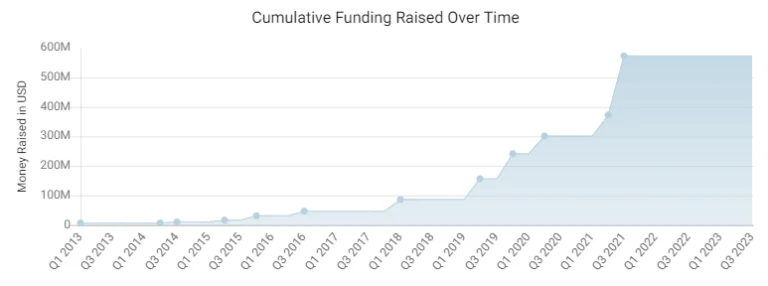
Canva’s site performance is another voice in the positive story of the path that they’re on. As seen in the image below, the site’s organic performance reiterates not only consistent growth, but an increase in pace over the last 2 years. Good signs of product meeting users where they are, understanding their needs and fulfilling them. Also a positive indication of spending money in the right places to fuel their momentum. Canva is up 65% in organic presence year over year, and up 106% from 2 years prior.

Google trends show some ups and downs consistent with releasing new features and possibly other PR efforts. Despite some fluctuations in volume the trend is overwhelmingly positive and adds its voice to the strength of their growth and progress.

11. DreamStudio:
DreamStudio is another prompt based, text-to-image AI image generation tool focussed on minimizing the energy required to generate their images. While the output may not initially seem as robust as some of it’s competitors, DreamStudio boasts an iterable version of images making it easy to edit and upscale.
DreamStudio is rather new to the seen as made apparent to their trended organic presence below. It would appear that while they saw considerable initial success, they’ve hit massive headwinds that could be indicative of getting some items out of priority.

The volume of searches around their brand was a little difficult as it appears that Google hasn’t yet identified a segment for their brand name that is separate from the generic search term. However, looking at the shape of the volume over the last year, it appears to correlate with the initial release and the drop in interest.

12. CoreIDRAW:
CorelDRAW is another vector graphics editor that focusses on illustration, layout, photo editing, and typography tools. They offers various design that including some AI-assisted functionalities.
While CoreIDRAW has been around for a while, they’ve managed to continue to grow their online presence and continue to provide content and features that meet the needs for a select user base which is apparent from their ranking and keyword acquisition of their website. CoreIDRAW shows a 6% increase year over year in organic presence, and 3% drop from 2 years prior.

While not explicitly negative, it’s clear that the volume trend indicating awareness and demand has seen a negative trend through 2021 and then some increased volume that has slowly trended negatively since. Despite this, it would seem that CoreIDRAW continues to thrive in the AI design tool space.

13. TopazLabs:
TopazLabs is a design tool that uses AI for image editing. Primarily to enhance the quality of images and videos with some pretty impressive results.
TopazLabs has seen some ups and down over the years, but is currently thriving and positively trending with their audiences providing the right kinds of content to be promoted in the search engine results pages and driving valuable traffic to their site. They grew 87% in organic presence year over year.

Google trends shows a very positive trend corroborating the story of their site’s positive performance. It’s clear that the volume of those aware and searching for the brand has bee on a steady increase.

14. Uizard:
Uizard is an AI design tool that can be used to create some pretty robust products like web applications, mobile apps, as well as desktop software with a pretty easy-to-use editor.
It’s clear from Uizard’s funding raised over the last 5 years, that they’re continuing to grow and anticipate further growth. They’re showing a massive 417% increase from quarter to quarter in 2021.
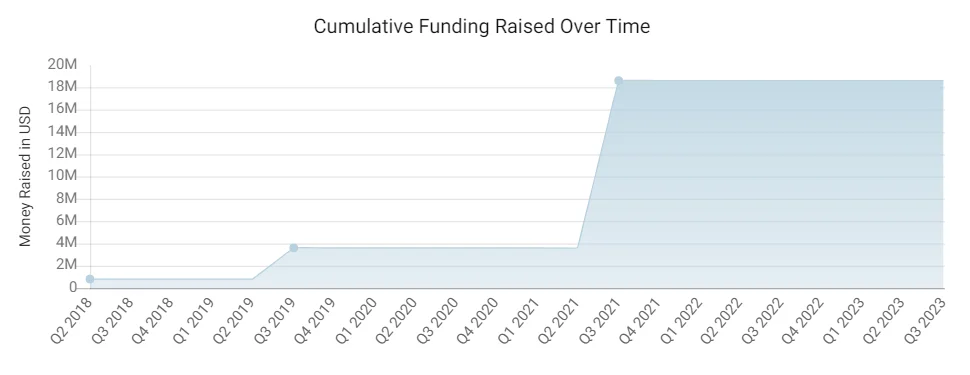
It appears that Uizard has been around for a few years, and while progressing, it hasn’t really taken off until 2023 where it’s seen considerable growth. Uizard is up 327% year over year in organic presence!

Google trends corroborates the story with minimal search volume seen since 2018, and then in 2023 it appears consistently and trending positively. Whether this is due to some good marketing and well spent PR funds, increased functionality and features or some combination of both, it’s clear that Uizard is making its way into the space and generating some pretty big waves.

15. Autodraw:
Autodraw is the last product we’ll include in today’s list of AI Design Tools trends and statistics. While small, Autodraw has been around for a handful of years and is one of the few to start before the AI boom. Providing value early on, AutoDrawl allows users to illustrate to their heart’s content, and the tool will use machine learning to take a guess at the illustration and then provide a closely related professional version to be used.
From the graph below, it’s clear that Autodraw has been through some ups and downs since its inception. While Autodraw shows a 28% decrease in organic presence year over year, it’s able to boast a 140% increase from 2 years prior which is still a positive trend for the lifespan of the company.
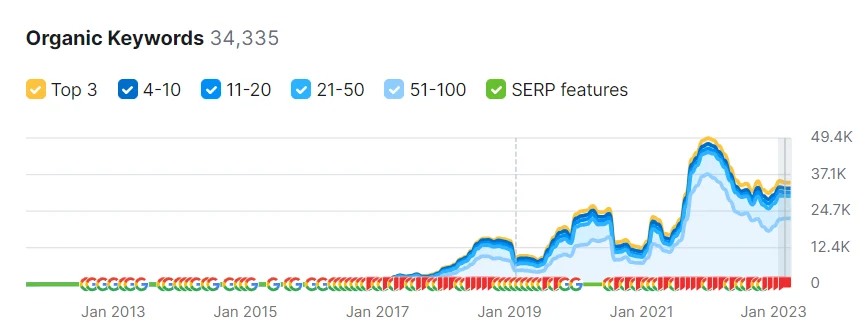
The volume illustrated in Google trends reflects roughly the same story, with a recent drop in interest through the last couple of months.

Growth in AI-Integrated Design Platforms
Major design software companies have recognized the potential of AI in design and are rapidly integrating AI capabilities into their platforms. The inclusion of AI-powered plugins, features, and modules has transformed traditional design software into intelligent ecosystems that support designers in their quest for excellence. Notable players in the industry report a considerable increase in user adoption of AI-integrated tools.
Data Security and Privacy Concerns
As AI design tools rely on vast amounts of data for analysis and decision-making, data security and privacy concerns arise. Designers and organizations need to address these issues diligently, ensuring compliance with data protection regulations and safeguarding sensitive design assets. An informed approach to data handling is crucial to ensure trust and confidence in AI design tools.
Bridging the Gap Between Designers and Developers
AI design tools are bridging the gap between designers and developers, fostering better collaboration and communication between the two disciplines. AI-powered design platforms facilitate smoother handoffs by generating design specifications and assets that developers can readily work with. This alignment leads to more efficient development cycles and reduces friction in the design-to-development process.
Conclusion
The advent of AI design tools has ushered in a new era of creativity and efficiency in the design industry. As AI technology continues to advance, designers can expect even more sophisticated tools that amplify their capabilities and enhance the overall design process. By embracing data-driven insights and combining them with their creative vision, designers can harness the full potential of AI design tools to shape the future of visual communication and user experiences. As we move forward, the harmonious collaboration between human ingenuity and artificial intelligence will continue to redefine the boundaries of design innovation.
AI Design Tool Statistics FAQs
AI design tools refer to a new generation of design software that incorporates artificial intelligence and machine learning capabilities. Unlike traditional design software, AI design tools can automate repetitive tasks, offer intelligent design suggestions, and analyze user data to enhance the user experience. These tools empower designers with data-driven insights, enabling them to create more personalized and efficient designs.
AI design tools improve design efficiency and productivity by automating time-consuming tasks, such as generating design variants, creating layout suggestions, and automating design handoffs to developers. By leveraging AI-powered features, designers can focus on the creative aspects of their work, leading to faster design iterations and better overall productivity.
According to market research, the global AI in design tools market has witnessed significant growth in recent years. Several leading AI design tools have amassed millions of users, indicating their popularity and widespread adoption in the design community. Surveys also reveal that a substantial percentage of design professionals report increased design efficiency and improved user experiences through AI-powered design solutions.
AI enables designers to create more personalized user experiences by analyzing user data and behavioral patterns. Designers can use AI-driven insights to understand user preferences, optimize content layouts, and offer personalized recommendations. By tailoring designs to individual users, designers can deliver more engaging and relevant experiences, ultimately leading to higher user satisfaction and loyalty.
In most organizations, the disconnect between brand and the rest of the organization is real.
On the one hand, brand and creative teams are constantly bombarded with requests, trying to fulfill as many as possible with limited time and resources. Most requests come with unrealistic turnaround times, leaving creative teams in a tough place to deliver.
And on the other hand, creative teams sometimes evolve into the “brand police,” which can make a brand feel “off limits” to other orgs. Doing so limits cross-functional creativity, introduces creative bottlenecks, and creates a negative dynamic between brand and other teams.
The result? Creative teams feel like short-order cooks feeding the never-ending content beast, and customer-facing teams start creating rogue content when marketing can’t fulfill their one-off requests.
That’s why modern organizations need a brand enablement solution that puts the power of your brand in the hands of your employees without sacrificing the most critical elements of your brand.
What Is Brand Enablement?
Brand enablement is the strategic process of equipping teams across your organization with the content, guidelines, and tools they need to promote your brand effectively.
It’s much more than a brand guide; it’s the process of empowering your people to promote your brand across the channels they’re in every day.
Modern brand enablement solutions help your people promote your brand by:
- Connecting employees to the most up-to-date content pieces
- Allowing employees to personalize content when they need it most
- Giving visibility into the content teams are creating
- Speeding up the approval process for quicker turnaround times
- Getting more personalized content into the hands of your customers
Organizations with Brand Enablement vs. Without
To compete in today’s fast-moving market, teams need a way to produce highly-personalized content for their customers at any given moment. For most businesses, content is the key to convincing potential buyers that you’re the right business for the job.
But without a brand enablement solution, it can be easy to overload creative teams with an endless queue of content requests.
Let’s look at how brand enablement can unleash your brand’s potential while saving your organization time and money.
 Brand Enablement Drives Business Growth
Brand Enablement Drives Business Growth
By equipping your teams with proven brand enablement tools, you’re making it easy for every existing and potential customer to have a meaningful interaction with your brand.
With easy access to lockable brand templates, your teams can deliver personalized content to potential customers faster than ever. This unique approach takes the burden of small content requests off of design teams and gives customer-facing teams the tools they need to win business.
 Brand Enablement Speeds Up Content Creation
Brand Enablement Speeds Up Content Creation
When potential customers come to you, they want to know instantly how your product or services can solve their problems.
They don’t want generic content; they want content that’s tailored to their needs.
With a brand enablement solution, team members can choose an approved template, customize it, and send it to a customer. This process shortens turnaround times, guarantees brand consistency, and removes tedious requests from the creative backlog.
 Brand Enablement Improves Brand Reputation
Brand Enablement Improves Brand Reputation
Opening up content creation to everyone doesn’t mean content chaos. It means you’re empowering your people to promote your brand the right way.
With lockable templates, team members can personalize and deliver fresh content that’s always compliant with your brand standards.
Creative teams have complete visibility into the content being created, and customer-facing teams feel empowered with a way to create on-brand content.
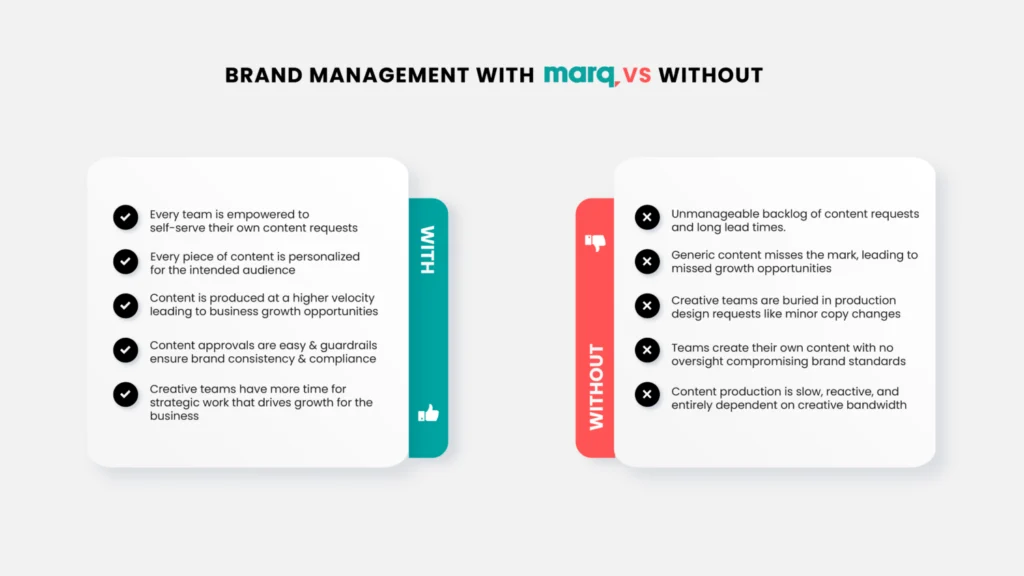
How to Implement Brand Enablement
Whether implementing brand enablement from the ground up or refining a system already in place, you’ll want to take inventory of your current brand assets and creative processes. Doing so will help you identify gaps to build a more holistic brand enablement plan.
Here are six steps we recommend you take when getting started with brand enablement:
Step 1: Create a culture of alignment
How well do your brand and creative teams collaborate with other departments?
Without a solid brand enablement process in place, your answer might be: “Not that well.” And that’s okay.
Your first goal is to build cross-functional relationships across the company to ensure everyone is aligned with your brand enablement vision.
Step 2: Determine the content goals of other departments
For brand enablement to work, you need to equip your teams with the content types they need to be successful. Take the time to identify cross-functional partners’ content needs and goals and build them into your content production plans.
Step 3: Establish clear brand guidelines
When it comes to branding, consistency is everything. Whether you have a brand style guide or a brand enablement platform like Marq, make sure you have a source of truth that outlines everything that matters to your brand, from typography and color to logos and imagery.
Step 4: Choose the right technology to facilitate content creation
Multiple file types across hundreds of programs create a mess of content only usable by the original content creator. You need shared technology that won’t break the bank, ensures brand consistency, enables users to self-serve their content needs, and empowers everyone to personalize and share content easily.
Step 5: Implement a process for approvals and check-ins
Brand control doesn’t stop with brand enablement. Instead, it should be easier to get content out the door, and content approvals should work for you, not against you. Align on a process that works for your cross-functional teams and brand protectors.
Step 6: Establish performance metrics and implement feedback loops
Your content is only effective if it drives results. Decide what metrics you will use universally to measure performance and create feedback loops so your team is always looking at the data to drive better content decisions.
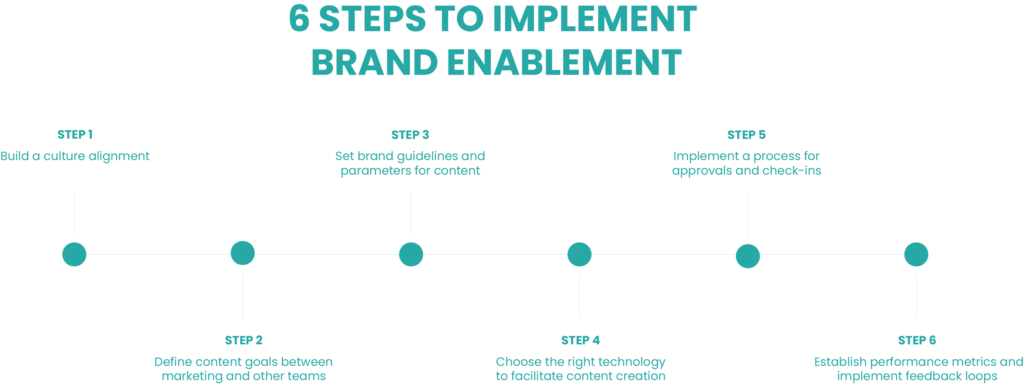
How Marq Makes Brand Enablement Easy
Not all brand enablement tools are built the same, but the best, most comprehensive brand enablement platforms will empower your teams to create stellar on-brand content that drives growth for your business.
With Marq’s ability to convert all of your designs into reusable branded templates, everyone in your org can create and share on-brand content.
Here’s how Marq works:
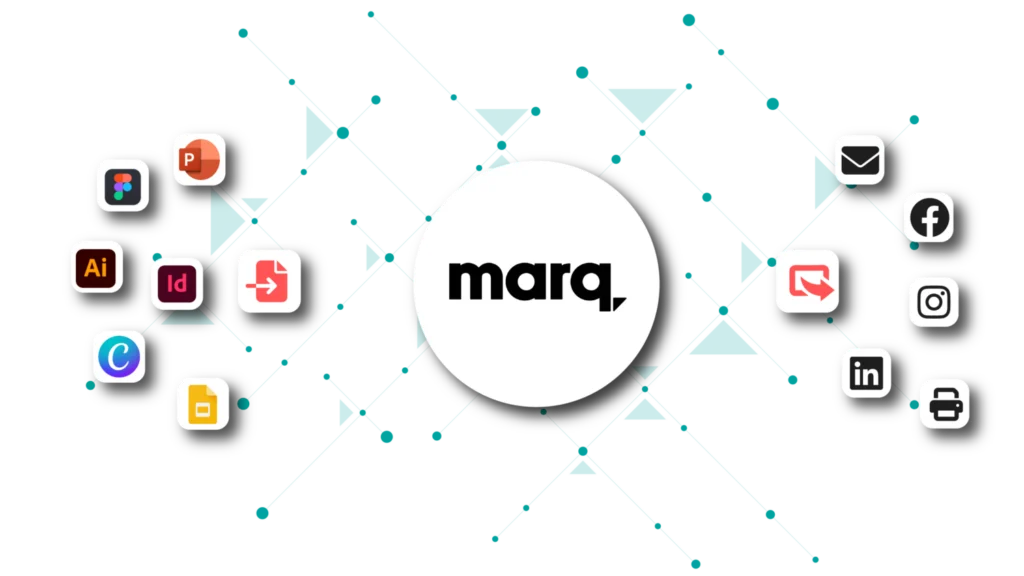
01 Design Anywhere
Creative teams can import existing design files from any platform or create designs locally in the Marq editor.
Why organizations love this
- Creative teams can build designs on the platforms they’re most comfortable with
02 Templatize Anything
With Marq, you can turn any design into a template by locking critical brand elements like fonts, logos, and colors.
Why organizations love this
- Creative teams create one version of a lockable brand template instead of updating the same design file hundreds of times.
- Other teams can access approved templates for pitch decks, social posts, one-pagers, and more.
03 Personalize Everything
Share brand templates across your organization so teams can customize content for their unique audiences.
Why organizations love this
- Creative teams save time by allowing teams to fulfill their own content requests.
- Other teams can quickly personalize approved templates without submitting a creative request.
04 Share Everywhere
Teams can immediately publish content without having to leave the Marq platform. Quickly post any project to social media, send it to print, or embed it in an email.
Why organizations love this
- Creative teams feel confident that every piece of content that’s shipped meets brand standards.
- Other teams win more deals by getting content into the hands of customers faster.
Imagine the content output and level of personalization when you put brand enablement to work for your organization.
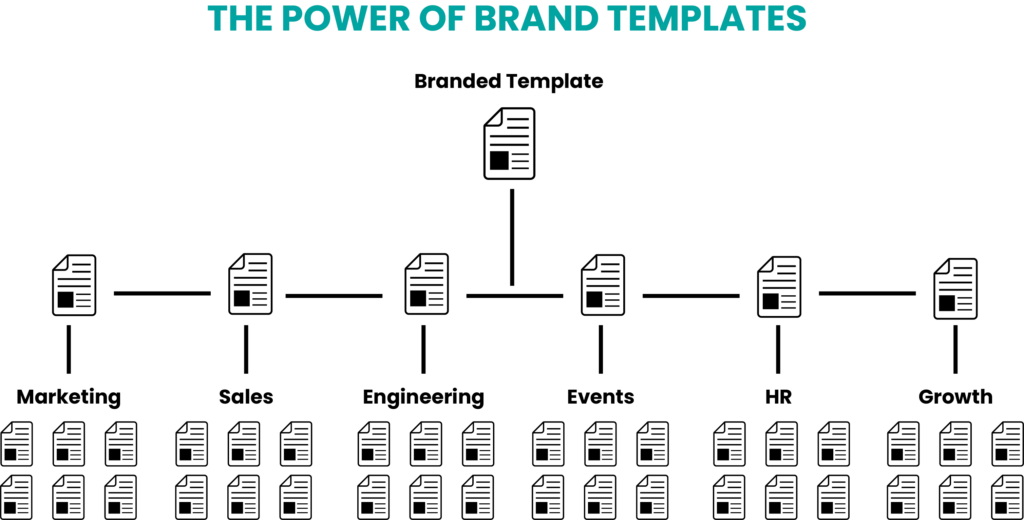
Upgrade your brand management strategy to a brand enablement strategy today. You can schedule a demo here.
Brand Enablement FAQs
Brand Enablement is a strategic approach that goes beyond traditional branding. While branding focuses on creating a brand identity and recognition, Brand Enablement takes it a step further by empowering brands to thrive in the modern marketplace. It involves providing brands with the necessary tools, technologies, and resources to enhance their presence, engage their target audience, and adapt to evolving market trends. Essentially, Brand Enablement enables businesses to translate their brand vision into tangible, sustainable success.
Brand Enablement offers numerous benefits for businesses seeking to establish a strong market position. By investing in Brand Enablement, your business can:
Drive Customer Engagement: It helps you create compelling brand experiences that resonate with your target audience, increasing customer loyalty and advocacy.
Competitive Advantage: Brand Enablement allows you to differentiate your brand, making it more memorable and recognizable in a crowded marketplace.
Adaptability and Innovation: With the right tools and technologies, Brand Enablement empowers your brand to adapt quickly to changing market conditions and embrace innovative strategies.
Brand Consistency: It ensures consistency across all brand touchpoints, including online and offline channels, fostering trust and credibility among customers.
Employee Alignment: Brand Enablement aligns your employees with the brand vision, fostering a sense of purpose and enhancing overall productivity.
In this episode of Group Therapy, Katie Krongard, Associate Creative Director at Marq, sits down with Brett Barlow, CEO of Everee and former Chief Brand Officer at Pluralsight. They discuss why creatives need to build stronger partnerships with cross-functional teams by investing time into sharing brand initiatives internally while learning how to support their entire organization better.
They also talk about how to build strong brand and marketing teams focusing on start-ups and the characteristics that make brands stand-out against the competition.
This is the fifth installment of Group Therapy, a content series hosted by Marq- the brand enablement platform empowers everyone within an organization to build and deliver branded content to their audience.
In this episode of Group Therapy, hosted by Marq, Chris Knudsen, former CMO at Purple, and Cole Parker, Senior Product Marketing Manager at Marq, discuss the state of video marketing and the obvious trends many brands are ignoring.